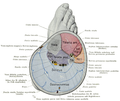Fascial compartments of leg
| Fascial compartments of leg | |
|---|---|
 Cross-section through middle of leg. Four compartments painted in different colors. | |
 Muscles of the lower leg. Four compartments painted in different colors. | |
| Anatomical terminology |
The fascial compartments of the leg are the four
blood supplies separate from their neighbours. All of the muscles within a compartment will generally be supplied by the same nerve
.
Intermuscular septa
The lower
transverse intermuscular septum and the posterior intermuscular septum.[1]
Each compartment contains connective tissue, nerves and blood vessels. The septa are formed from the fascia which is made up of a strong type of connective tissue. The fascia also separates the skeletal muscles from the subcutaneous tissue.blood flow to the muscle can be blocked, leading to a condition known as compartment syndrome. Severe damage to the nerve and blood vessels around a muscle can cause the muscle to die and amputation might be necessary.[4]
Compartments
| Image | Compartment | Muscles | Neurovascular structures |
|---|---|---|---|

|
Anterior compartment |
|
Deep fibular (peroneal) nerve and anterior tibial vessels |

|
Lateral compartment | Superficial fibular (peroneal) nerve and fibular artery | |

|
Deep posterior compartment |
|
Tibial nerve, posterior tibial artery and posterior tibial vessels such as the fibular artery |

|
Superficial posterior compartment |
|
Tibial nerve |
Additional images
-
Animation
-
Cross-section of the right leg.
See also
- Fascial compartments of arm
- Fascial compartments of forearm
- Fascial compartments of thigh
References
- S2CID 31965215.
- ^ Saladin, Kenneth S. (2012). Anatomy and Physiology: The Unity of Form and Function. New York: McGraw Hill. p. 315.
- ^ "How Veins Work".
- ^ MedlinePlus Encyclopedia: Compartment syndrome
External links
Wikimedia Commons has media related to Fascial compartments of the leg.


